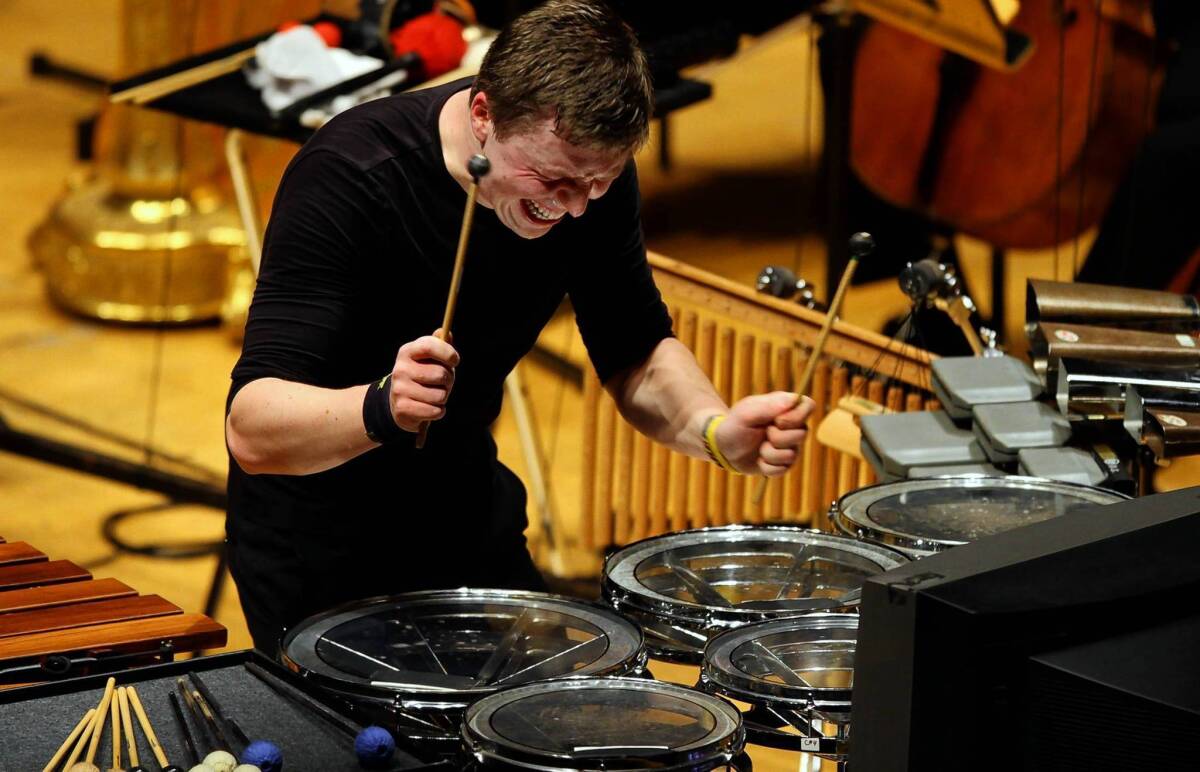Classical music review: Tan Dun offers fresh sounds for a new year

- Share via
It’s a new year, and the Los Angeles Philharmonic celebrated with a new concerto, or at least a nearly new one. Tan Dun’s “The Tears of Nature,” which features a whiz-bang percussionist and orchestra, is an L.A. Phil co-commission involving four orchestras. A radio orchestra in Lübeck, Germany, gave the world premiere last month.
But though the concerto’s U.S. premiere Friday night at Walt Disney Concert Hall by percussionist Martin Grubinger and guest conductor Christoph Eschenbach was but a deuxième, the L.A. Phil’s very first notes of 2013 were still fresh and wondrous. Moreover, the orchestra does have a completely new concerto coming up mid-month with the world premiere of Peter Eötvös’ “DoReMe,” a violin concerto for Midori.
Such faith in the now may seem an unusually, even uniquely, optimistic outlook these days for an American orchestra, given how some are fighting for their survival. Nevertheless, Tan describes “The Tears of Nature” as a cautionary concerto. “Throughout the music,” he is quoted in the program notes as saying, “nature’s tears tell us that the threat to our survival is ourselves.”
GRAPHICS: Faces to watch in 2013
That’s quite a message for abstract music to convey. Without more specific help decoding the score’s ecological semiotics, I’ll steer clear of interpreting the symbolism. Simply getting a handle on Tan’s music is a task in itself.
The physicality, the earthiness, is one of its great attractions. The composer, who grew up in China and moved to New York in 1986, adamantly melds East with West. But he often complicates the picture by seesawing between high and low.
Consequently, orchestras are not always prepared for Tan. As part of the opening celebrations of Disney Hall in 2003, the L.A. Phil commissioned a concerto for paper instruments that might appeal to children. The piece fell flat, perhaps because Tan had previously used paper instruments to accompany erotic dance. When the Paper Concerto was revived three years later in a sexy Stockholm performance, it proved a sensation.
“The Tears of Nature” has a little of everything in it. Actually, it has a lot of everything in it. Grubinger, a young Austrian percussionist, is an eager showman with a fabulous technique, and Tan has taken to him with seemingly huge appetite. The work was projected to be 27 minutes. Friday, it clocked in at 39.
2012 in review: L.A.’s top 10 arts and culture stories
The first movement began stunningly with a muted harp sounding like an twanging Asian instrument. Grubinger’s entrance was made by quietly tapping stones (nature’s tears?) as he walked from the front of the stage, where he had an elaborate percussion setup, to the orchestra’s percussion section in the rear. There, the soloist had access to a bank of timpani on which he pounded with mad abandon before quietly (and with a slight smile that I think he was trying to suppress) tapping his stones once more as he returned to the front of the stage.
Tan’s orchestral writing is color drenched. One minute, we could be reminded that he’s an avant-gardist communing with sound as sound (he recently conducted a concert in China where he introduced new pieces meant to be in dialogue with John Cage). The next minute, he can be a happy Hollywood composer blockbuster-bound (he won an Oscar for his “Crouching Tiger, Hidden Dragon” score).
Still, attention focused on Grubinger, who is not just an athletic percussionist (he eschews concert tails for a fitted black T-shirt) but also an acrobatic one. The concerto’s cadenzas appeared designed for an octopus, what with Grubinger ever grasping for bowls, blocks, bells, gongs, drums, marimba, vibraphone and rainstick.
In some of Tan’s recent orchestral music, he takes a simple melodic motive and doesn’t let go of it, drumming it in, so to speak, in every which way and with every kind of instrumental combination imaginable. That describes the final cadenza. But what might have been a cheap trick turned into such an exuberantly elaborate one that I fell for it, and so did the rest of the audience, if the huge applause was anything to go by.
PHOTOS: Arts and culture in pictures
Grubinger’s encore was something he wrote, he told the audience, but wasn’t really music. It was, indeed, more a magic trick with a military drum, involving juggling and what I would have thought superhuman velocity.
Eschenbach followed the concerto with Tchaikovsky’s Fourth Symphony, which also has an encoded fate-based message. This is no novelty hereabouts. Alan Gilbert’s New York Philharmonic brought it to Disney last spring. Gustavo Dudamel conducted it at the Hollywood Bowl in August. Edward Outwater led it with the Pasadena Symphony in November. All were exciting.
What made the Eschenbach’s performance distinctive was the way he tied Tchaikovsky into Tan by emphasizing the score’s dazzling use of instrumental color and the L.A. Phil’s dazzling virtuosity while remaining ever elegant.
MORE
INTERACTIVE: Christopher Hawthorne’s On the Boulevards
VOTE: What’s the best version of ‘O Holy Night’?
PHOTOS: Arts and culture in pictures
More to Read
The biggest entertainment stories
Get our big stories about Hollywood, film, television, music, arts, culture and more right in your inbox as soon as they publish.
You may occasionally receive promotional content from the Los Angeles Times.











